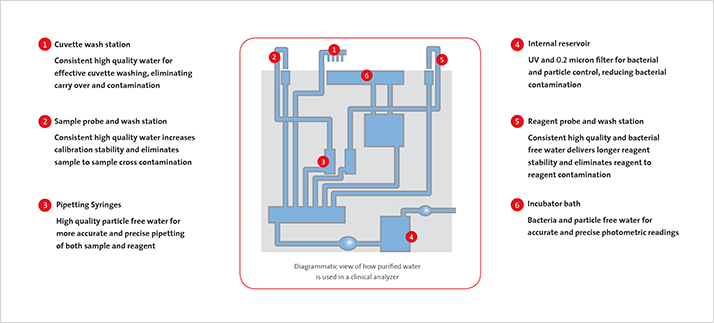Summary
Clinical grade water is clearly essential in a clinical laboratory and the trend is certainly towards higher purity requirements to meet the range of analyses carried out. Poor water quality not only affects the tests themselves directly but also impacts on all aspects of analyzer operation. Good water purification design, especially providing recirculation through the key purification technologies, is the key to effective and long-term bacterial control, which is the most challenging aspect of water purification. This approach, combined with duplex operation and good support will provide the water needed.

Introduction
Water purity has always been important in clinical diagnostics but on-going developments in the approach to clinical testing and in the sophistication and range of tests available have made water purity even more critical. The key requirements for water for clinical analyzers are:
- Highly reliable, uninterrupted supply
- Consistent high purity
- Low running costs
- Easy operation and minimal user intervention
Traditionally, analyzer feed water systems were mainly for chemistry-based analyzers that used principally colorimetric and ion selective electrode technologies. The overall trend towards less invasive technologies has led to smaller blood and other samples and their use for a wider range of tests. 500μl samples have to provide material for the initial tests and with some in reserve for retests or further studies. This has become feasible with improvements in pipetting techniques which enable high accuracy at volumes of only a few micro-liters. Sample dilution with clinical grade water prior to assay puts extremely high demands on the water purity as the effects of any contaminants are immediately multiplied by the dilution factor. Limited samples may also restrict scope for retesting, adding extra clinical pressure to the financial pressures of ensuring that reliable results are obtained first time.
Uses of Clinical Grade Water
 Figure 1: Uses of Pure Water
Figure 1: Uses of Pure WaterIncreasingly, automated immunoassay systems have been introduced into routine clinical chemistry labs. These tend to use disposable cuvettes and sample pipette tips but still need pure water for reagent probe tip washing, pipetting and dilution of bulk reagents. Generally a higher quality of water is required for immunoassay because of the highly sensitive technologies used, such as chemiluminescence, either direct or indirect, or time-resolved enzymatic fluorescence. Many tests rely on multi-stage processes using enzymes such as alkaline phosphatase. Any drop in water purity can seriously impact on the quality and reliability of these assays. Currently automation within clinical chemistry labs has progressed to group all the high volume tests together onto common platforms irrespective of the measuring technology. It is fairly commonplace now to use systems like the Abbott Diagnostics ARCHITECT® ci8200 and the Roche cobas® 6000 platform, both of which combine immunoassay and chemistrybased tests. The water feeding these systems tends to be used by both types of technology, and so all the water has to be pure enough for the more sensitive immunoassay technologies.





